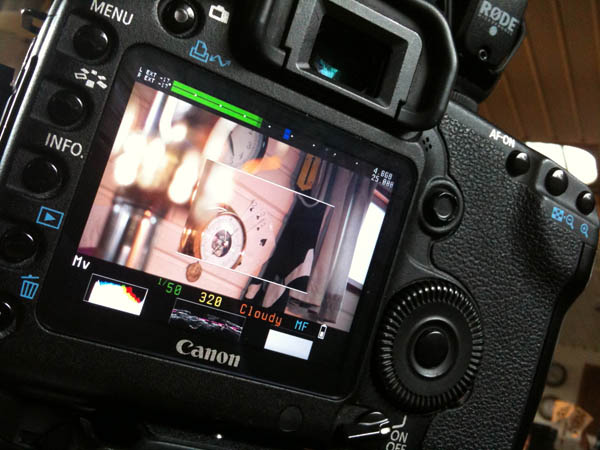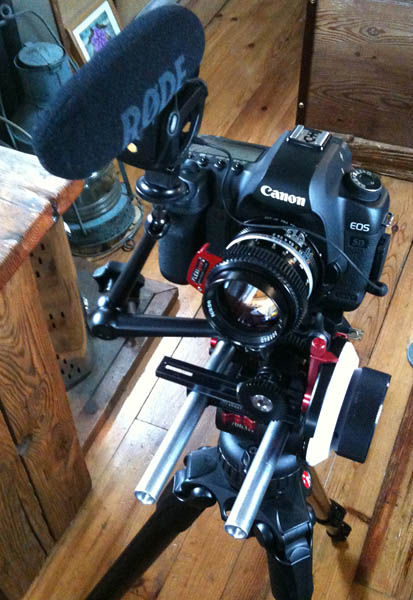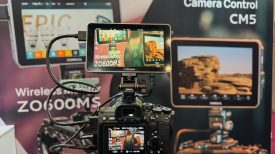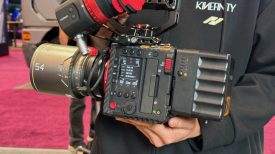Guest post by Marcus Waterloo:

Just as I got early access to the new Magic Lantern hack (v2.3 RC2), a friend from Songlines magazine asked me to take some pictures of the Ethiopian band Krar Collective. So I decided it would be fun to see if I could do a short impro session and test the hack at the same time. Here’s a quick edit of the shoot (the only grading was a little desaturation, of 10 to 5 percent).
I took my Canon 5D mkII with a Rode VideoMic Pro plugged directly into the camera and no monitor or loupe. Picture style on the camera was Marvels Advanced and I just set up one light, an LED panel.
KRAR COLLECTIVE from marcus waterloo on Vimeo.
I only had about half an hour to do everything before the delicious food arrived, as we were in the lovely Muya Ethiopian restaurant in Camden. So I got the band to run through the song three times and shot it on two lenses; a Voigtlander 40mm f2 and a Nikon 85mm f2.
For those of you who haven’t been following the Magic Lantern development, it’s basically a freely available hack to the Canon EOS camera’s firmware. It is easily installed and compliments the camera’s original functions with an additional set of menus full of useful and very exciting adaptions of the camera’s functions.
It’s been developed by a group of generous and enthusiastic people in an open source evolution. They have a new website: http://www.magiclantern.fm/. The hackers always give a very clear disclaimer that the hack can damage your camera, but because of the brave few in the community who have supported and tested this software, they seem to have developed something that is less scary to use on one’s precious camera. The first version I used did occasionally crash my camera and give me a few cold sweats – before I realised all you had to do was turn the camera off and remove the battery for a few moments. That classic nugget of repair advice; turn it off and on again.
I found the new version of the hack very stable and a great help with the sound; being able to adjust the levels during the take is amazing. I know how important sound is, but I’m not really a sound person, and just being able to plug the mic straight into the camera with the AGC disabled for little shoots like this is massively useful.

Using the Magic zoom (expanded focus box) during the take was a wonderful help too. As I had only a bare bones set-up this really helped me check focus during the take. Allowing you to turn it on and off and move it around whilst recording too is a work of genius.
Among the many other exciting features, I think these two are indispensable and with the stability of the hack really improve the camera. I also very much valued being able to have frame guides in camera too.
I did shoot with a higher bit rate setting, but this shoot wasn’t a scientific run through; more of a user friendly test (which the hack passed with flying colours). I made a mistake with the ASA settings as I was rushing through taking some stills as well and left the camera set on 1000 ASA – which I feel wouldn’t help the noise level on video. So, it’s probably not best to judge the image quality. My main conclusion is that it really helped, keeping my set up very simple, and will be a trusted addition to a great tool, specially for small impromptu shoots such as this.
ASTON MARTIN CYGNET from marcus waterloo on Vimeo.
It would have been great to have this on a one-man-band shoot on 5D and 7D I did recently in Hong Kong, as I was doing a lot of shooting just hanging out of car windows, handheld, without a monitor for framing or focus aids. If I’d had this hack then I would have had an even higher hit rate of good shots on a shoot where we were really dashing around.
The hack has evolved in really great ways since I last used it. I do think it’s incredible what the Magic Lantern people have done – and all for free. They really deserve the donations you can give on their site.
You can see more of Marcus’ work on his website www.marcuswaterloo.com






